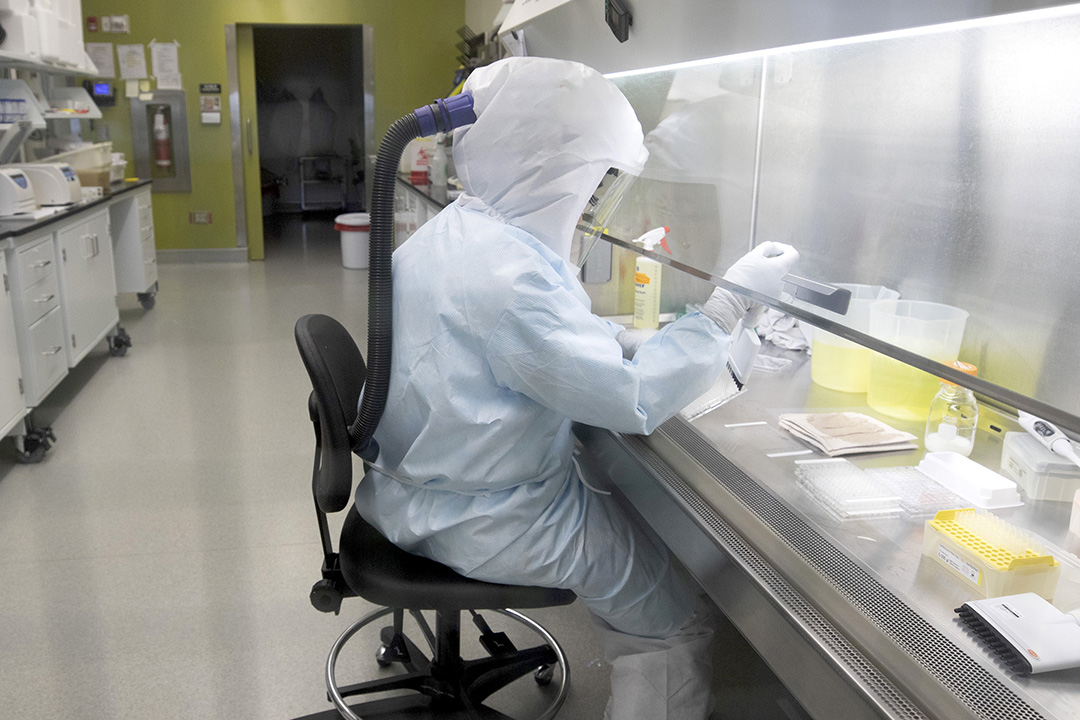
PM announces $12M for new vaccine manufacturing at USask’s VIDO-InterVac, part of $23.3M for the lab to fight COVID-19 and other infectious disease threats
SASKATOON – As the COVID-19 outbreak continues to rapidly evolve, the federal government is announcing $23.3 million in total support for the University of Saskatchewan’s (USask) Vaccine and Infectious Disease Organization – International Vaccine Centre (VIDO-InterVac), one of the largest and most advanced infectious disease research facilities in the world.
By USask Research Profile and ImpactAs part of the government’s $275-million fund for COVID-19 health research, Prime Minister Justin Trudeau announced that VIDO-InterVac will receive $12 million to help address Canada’s shortage of vaccine manufacturing capacity, as well as $11.3 million for continued operational funding for high containment laboratories over the coming year.
“This new federal funding recognizes that VIDO-InterVac is at the forefront of global efforts to develop a vaccine for COVID-19 and other infectious disease threats,” said USask Vice-President of Research Karen Chad. “This is critical work at VIDO-InterVac that will help protect the health and safety of all Canadians, as well as people around the world.”
VIDO-InterVac is constructing a pilot-scale manufacturing facility on campus to accelerate vaccine development in Canada and abroad.
“The $12 million enables us to build the facility to Good Manufacturing Practices standards as required for human vaccine production,” said VIDO-InterVac Director Volker Gerdts. “We expect to begin vaccine production in a little more than a year.”
The $12 million is from Western Economic Diversification’s Regional Economic "Growth Through Innovation” program.
There is currently no vaccine for COVID-19 coronavirus. VIDO-InterVac is the first lab in the country to have a vaccine candidate in animal testing. The vaccine was made in February, and researchers expect to know in about four weeks whether the vaccine works in an animal model. Clinical testing of this vaccine in humans could start as early as this fall.
The $11.3 million comes through the Canada Foundation for Innovation under the federal Major Science Initiatives program which funds the operations of major science facilities.
“InterVac is part of the national and global response to emerging disease threats such as COVID-19 in humans and African swine fever in animals,” said Gerdts, who is participating in three World Health Organization expert groups on animal model and vaccine development for COVID-19.
As one of the few Canadian research facilities with regulatory approval to work on the new virus, VIDO-InterVac was the first lab in the country to isolate the virus. This was done over five weeks ago, in collaboration with the Public Health Agency of Canada and Sunnybrook. The isolated virus was made available to federal and provincial laboratories.
VIDO-InterVac is also the first lab in Canada, and one of the very few in the world, to establish an animal model for COVID-19. Suitable animal models are critical to evaluate vaccines, antivirals and therapeutics. The lab’s animal model is now available to industry and academic partners from around the world.
In addition to vaccines, VIDO-InterVac is also testing antivirals and therapeutics from various Canadian and multinational companies, including two in China.
A world leader in developing vaccines and technologies to combat infectious diseases, VIDO-InterVac was recently awarded $1 million through the federal rapid research funding initiative for research projects aimed at addressing COVID-19.
In last week’s provincial budget, the Saskatchewan government announced $400,000 for VIDO-InterVac’s manufacturing facility. Innovation Saskatchewan also recently announced $200,000 for VIDO-InterVac’s COVID-19 research.
-30-
For more information, contact:
Victoria Dinh
Communications and Media Relations Co-ordinator
University of Saskatchewan
victoria.dinh@usask.ca
306-966-5487
Trenna Brusky
Marketing Co-ordinator
VIDO-InterVac
Trenna.brusky@usask.ca
306-966-2274
Article re-posted on .
View original article.
